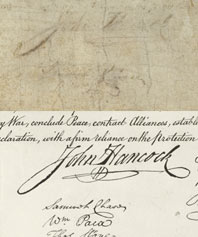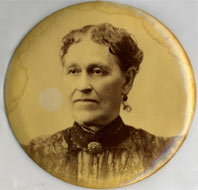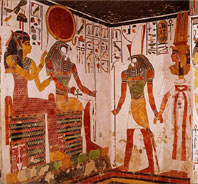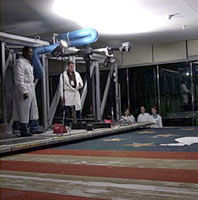|
Color photos, old newspapers, the Declaration—we've all seen materials
damaged by long-term exposure to light. But what's actually happening?
The Declaration of Independence took a lot of abuse in the first decades of its
life. It was rolled and unrolled countless times. It was tossed in a trunk or
stuffed in a linen bag and whisked away every time the British Army got too
near. And for 35 years, beginning in 1841, it was hung on a wall in the Patent
Office in Washington, D.C., across from a sunny window.
The harm this last insult caused is apparent in a quote from the Public
Ledger in 1876, when the Declaration was taken off that wall and
transported to Philadelphia for the centennial. "Its aspect is ... faded and
time-worn," the Ledger noted on May 8 of that year. "The text is fully
legible, but the major part of the signatures are so pale as to be only dimly
discernible in the strongest light ... and some are wholly invisible, the
spaces which contained them presenting only a blank."
Light is likely not the only reason the Declaration has become so faded. In the early 1820s,
an engraver made a facsimile possibly by laying a piece of
moist paper over the Declaration to soak up some of the original ink. But light
streaming through that Patent Office window surely further reduced the
legibility of our nation's most precious handwritten document.
And fading of color or ink is only the most obvious injury that light can
cause. In the presence of oxygen or moisture or temperature changes—or,
worst of all, all three—light can trigger chemical reactions that can
degrade the very substance of the parchment, paper, textile, or other material
from which items of artistic or historical interest are made. In fact,
considering the number of ways that light-induced chemical reactions can wreak
havoc, it's amazing that such items survive for any time at all.
 A bad reaction
A bad reaction

Light is paradoxically both our best friend and worst enemy when it comes to
enjoying our most beloved works of cultural heritage. For it is light that
makes visible the rich reds, oranges, and yellows of a Turner sunset, say, or
the deep blues of a Picasso blue-period painting, or for that matter the dark
brown ink gracing the Declaration. We see those colors because they reflect
light back to our eye from very specific parts of the visible-light portion of
the electromagnetic spectrum.
Unfortunately, what's not reflected is absorbed, and that's where the trouble
starts. Light is energy, and when that absorbed energy equals or exceeds the
so-called activation energy of a molecule in a dye, pigment, or ink—or in
the paper or other material it graces—the molecule becomes "excited,"
that is, rendered available for chemical reactions.
"From a preservation standpoint, that's exactly what you don't want," says Paul
Messier, a Boston-based conservator of photographs and works of art on paper.
"If your object is chemically active, it means it's interacting with the
environment and becoming chemically altered. Depending on the rate of those
interactions, you've got a recipe for poor preservation and a short life
span."
Why? Because any number of things, many of them destructive, can happen once a
molecule gets excited. The extra energy may be converted to heat (infrared
energy) or emitted as light (phosphorescence or fluorescence). It can break
chemical bonds within the molecule, creating smaller molecules and thereby
weakening the paper or parchment by shortening the long fibers that make them
strong.
Or it can jump to another molecule. In one of the most damaging of such leaps,
the energy transfers to an oxygen molecule, which can then react with other
molecules to jumpstart chemical reactions. Such oxidation is the bane of museum
curators, fine-art owners, and all of us who want to make things last, whether
they are national treasures like the Declaration or a newspaper clipping of a
personal milestone.
 Adding insult to injury
Adding insult to injury

But that's not all. There can be synergistic effects: with higher temperature
and humidity, for example, reactions catalyzed by electromagnetic radiation can
occur more rapidly. And there can be chain reactions: new substances formed as
a result of photochemical reactions will have enough energy to also react with
the original substance, launching a chain reaction of degradation.
Moreover, some kinds of light are more problematic than others. Light toward
the blue end of the visible spectrum, for example, is higher
frequency—and thus higher energy—than light at the red end. Thus it
packs a greater punch. And ultraviolet radiation is more energetic still. In
fact, it's the most damaging type of electromagnetic energy in our everyday
environment. Even relatively low-energy infrared radiation can damage materials
by heating them and thereby helping to speed any chemical reactions already
under way.

A 50-watt incandescent light bulb spews out 100 billion
billion photons a second, and 95 percent of those are not helping us to
see.

Conservators are concerned not only with frequency but with the
intensity of light hitting artworks or other valuables—daylight,
for instance, is typically brighter or more intense than artificial light. And
then there's exposure time. As the Declaration shows so clearly, light damage
is cumulative. It's also irreversible (except, as one expert reminded me, in
PhotoShop). Finally, and arguably most unfair of all, chemical reactions
initiated by light can continue even after something is placed in the dark.
 Substance abuse
Substance abuse

The range of our possessions at risk may be wider than you think. It includes
the media used to write, draw, and create photographs, such as dyes, inks,
pigments, varnishes, and oils, as well as the materials they're used on, like
paper, textiles, furniture, feathers, fur, horn, and bone.
Some of these materials are at greater risk from light damage than others.
Generally speaking, organic materials—those derived from plants or
animals—are more susceptible than inorganic materials. For instance,
natural dyes, which are organic, generally fade faster than pigments, which are
usually comprised of inorganic minerals. But even organic materials vary in
their stability: materials made of parchment, which is a
specially prepared animal skin, are less vulnerable than, say, silk and
wool.
The Star-Spangled Banner is a case in point. Both the dyes and the wool of our
country's most famous flag have been seriously light-degraded over time. And as
expected, the red dye is more faded than the blue. "The red dyes are more
susceptible to fading because they look red and thus absorb blue, and blue is
the higher-energy light," notes David Erhardt of the Smithsonian Center for
Materials Research and Education, who assisted the flag's conservation
project.
 Light housekeeping
Light housekeeping

What to do? Well, for starters, most art on display, whether in a museum,
gallery, or one's own home, is not being enjoyed at any given time. "It's got
all these photons smashing into it, and so for every minute while it's being
illuminated that nobody's looking at it, that's all wasteful damage," says
Steven Weintraub, a conservator at Art Preservation Services in New York.
"There are all kinds of efficiencies [we can adopt] in terms of UV filters,
reducing the amount of light in general, and shutting off lights when nobody is
around to look at it."
One thing is to remove all those wavelengths we can't see anyway from the light
striking a valued object. A 50-watt incandescent light bulb spews out 100
billion billion photons a second, and 95 percent of those are either
infrared or ultraviolet radiation, both of which are invisible to us. All those
unnecessary photons slamming into our watercolor or framed photo at 186,000
miles per second are not helping us to see; they're only helping to harm the
item.
The National Archives filters light on the Declaration to exclude higher-energy
blue wavelengths, for instance. "You're looking through multiple layers of
glass at a very low light level, and that light has had the harmful portion of
the visible spectrum removed from it as well as the ultraviolet," says
Kitty Nicholson, a conservator who worked on the Charters of Freedom
project (see A Conservative Approach). "So it's a very special light that both enhances the viewers'
visibility and also protects the document."
The National Archives also houses the Declaration in an oxygen-free encasement
filled with the inert gas argon, with carefully controlled moisture and
temperature. Some private institutions have gone further still, storing
vulnerable materials in such oxygen-free enclosures in temperatures near or
below freezing, in the dark. But that would be pushing it for many cherished
objects. As Messier says, "What good is material that you can never see? It's
all about figuring out the balance."


| 

John Hancock's famous signature dramatically reveals how
much the original Declaration (top) has faded versus the Stone Engraving made
in the 1820s.

| |

In the electromagnetic spectrum, the
shorter the wavelength, the higher the energy level of the radiation and thus
the greater the damage inflicted on light-sensitive materials.
| |

This 19th-century photograph was affixed with a
circular price tag (to left of subject's mouth above) and sold at an outdoor sale. When the new owner removed the
tag, the overall darkening of the image caused by that brief exposure to
sunlight was all too clear.

| |

For over 3,000 years, these mural paintings
in the tomb of Nefertari in Egypt's Valley of the Queens were protected from
excessive light, moisture, and temperature changes, hence their extraordinary
preservation.

| |

Smithsonian conservators photograph the
Star-Spangled Banner during a recent conservation project.

| |
|

